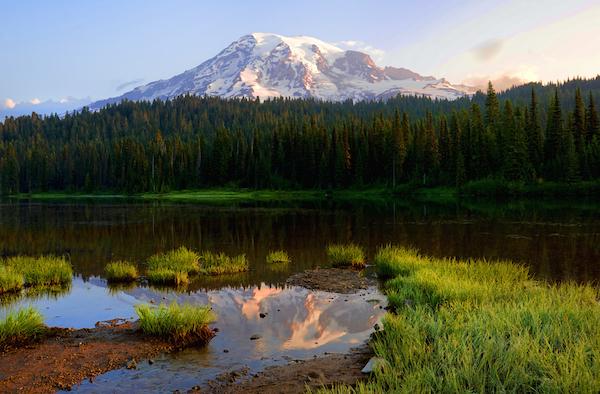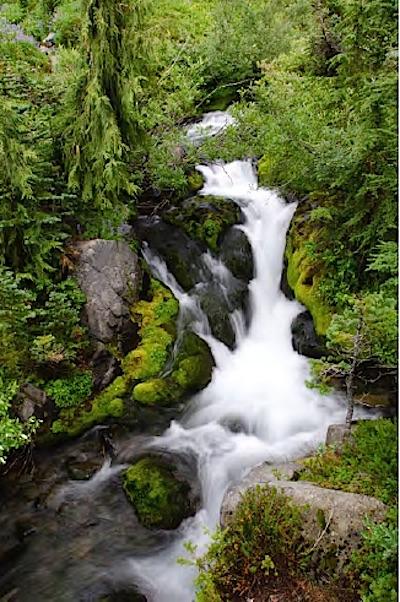
Standing on the horizon like an enormous ice cream sundae, minus the cherry on top, Mount Rainier lures visitors from near and far/Deby Dixon
It's easy to find Mount Rainier National Park from Seattle or Tacoma. Just point your vehicle toward the large, snow-cloaked mountain that stands against the eastern horizon and drive.
For the hour or so it took my son and me to drive from Tacoma, that icecream- sundae-vision served as our compass. The mountain steadily filled more and more of our windshield until we got into the forests just outside the park's year-round Nisqually Entrance, where stands of fir and hemlock surrounded us, allowing only glimpses of Rainier.
At more than a quarter-million-acres, this inviting Pacific Northwest landscape with its geologic and botanical wonders, Native American lore, hiking trails and shimmering waterfalls requires hands-on exploration. We were tempted to end our drive just 7 miles inside the park, at the Longmire Historic District with a room in the National Park Inn. This charming, 25-room inn, open yearround, has roots that date to the early 1900s and lures you with a front porch facing the mountain and short nature trails starting right across the road. However, our trip was just beginning.
We had reservations in Paradise; more specifically, at the Paradise Inn higher up on Rainier's flanks. Since it opened in 1917, this inn has been the base camp for visitors hoping to summit the 14,410-foot mountain, stride up onto its snowy flanks to build a spring snowman, or walk among the meadows of colorful wildflowers that begin blooming...in mid-July. As we enter the lobby, we are in awe of the massive cedar beams, rock fireplaces, and the imposing cedar chairs, tables, rustic piano, and ornate grandfather clock handcrafted by Hans Frahnke, a German carpenter, during the winter of 1919. If dining is your pleasure, you will find a large open dining room with tall, wood-framed windows that make it seem as if you're practically eating on the mountainside itself. Enjoy authentic Northwest cuisine and locally sourced menu items served up fresh for the entire family.
Across the parking area stands the Paradise visitor center. Originally built in the 1960s, the Henry M. Jackson Memorial Visitor Center was completely redesigned and rebuilt in 2006 to match the architecture of Paradise's historic buildings. Inside you'll find rangers to answer your questions, a short film, The Restless Giant, to orient yourself, and interactive exhibits on the mountain's wildlife, geology, and human history.
Mount Rainier, despite its icy appearance, offers a deceptively diverse landscape. There are leafy temperate rainforests filled with the loamy smells of moldering earth, the music of cascading streams and melodious birds, and trees, towering trees that dwarf us. Ever-present above this setting is the mountain with its massive snowfields and 25 named glaciers that make Mount Rainier one of the largest glacial systems in the world.

Though Mount Rainier is famous for its glaciers, they in turn feed a dazzling number of waterfalls plunging off the mountain/Deby Dixon
You can begin plotting your visit by heading to visitrainier. com and diving into 'the Basics.' Here you'll find an assortment of hiking information, details on what to pack for your day hike, tips for being a courteous hiker, and the exact location of trails in the Mount Rainier area. Dig a bit deeper on the website and you can bone up on fire lookout stations in the park, and overviews of five regions in the park: Sunrise, Carbon River, Ohanapecosh, Longmire, and Paradise.
Consider six driving tours that crisscross the park, from the direct route from the Nisqually Entrance to Paradise to the Circle Rainier route, which covers not quite 150 miles but can fill an entire day with the many stops worth making to marvel at the forests, waterfalls, and geology.
And to help build your vacation's photo album, check out the site's recommendations for photo hotspots not to miss.
Mount Rainier, though it has few roads, can overwhelm you if you don't have a specific itinerary. My son and I were frenetic, hiking up onto the snowfields one day, hiking down to admire 176-foot Narada Falls, pausing at Reflection Lakes to try to frame a black bear against the mountain, and winding up at Ohanapecosh.
We would have been wiser to study Visit Rainier's photo-rich listings of more than 130 hikes, with details on elevation changes, distances, and snow-free dates, and mapping out a strategic approach for our vacation.
Or to look at the organization's Top 10 list of spring activities, such as riding the Mount Rainier Scenic Railroad that showcases the rumpled, and river-cut, landscape outside the Nisqually Entrance, finding the perfect photo spot to catch both Myrtle Falls and Mount Rainier, or exploring the rainforest hugging the Carbon River just inside the park's northwest entrance.
Though it appears imposing when you start your drive to the park, when you're standing on the mountain's flanks you find an inviting landscape. It's one that, with a little advance preparation, welcomes you in and shows off its wonders.



Comments
Is it just me, or was this simply an advertisement for a particular website?
This isn't up to the Traveler's usual standards for this sort of article.
I disagree, Mega. After reading Kurt's article and logging on to the website, it looks like Kurt is passing along a very helpful pointer to all of us who may be planning a visit to Rainier. Someone has done an excellent job of setting up the website. I think using visitrainier.com in conjunction with the park's NPS website would provide a great way to maximize your time in the park.
Myself, I'll thank Kurt for letting me know this site exists.
I agree with Lee. I've been thinking of going to Rainier for 2 years now. Spent a few months last year "investigating". This site looks like it'll be a great help in scouting out where I want to go.
Thanks, Kurt. :)
Unless the Northwest's persistent high-pressure ridge migrates, peak flower season this year is more likely to be in May than July.